Marketing Report: Effectiveness of TV Ads for Australian Tourism
VerifiedAdded on 2020/02/19
|6
|2082
|363
Report
AI Summary
This report analyzes the significance of marketing and promotional activities in the tourism sector, with a specific focus on the Australian tourism industry. It highlights the use of television advertisements as a key marketing tool, particularly for brands like Tasmania Expeditions and Contiki. The report critiques the effectiveness of these advertisements, acknowledging their wide reach while also pointing out potential drawbacks such as misleading information and the limitations of celebrity endorsements. It then delves into the components of the marketing mix (price, place, promotion, product, people, physical evidence, and process) and their importance in successful tourism marketing. The report also discusses campaign planning approaches, including budget allocation and the selection of a unique selling proposition (USP). Ultimately, the report emphasizes the crucial role of effective promotional strategies in attracting tourists, boosting the Australian economy, and the government's initiatives in supporting tourism marketing.
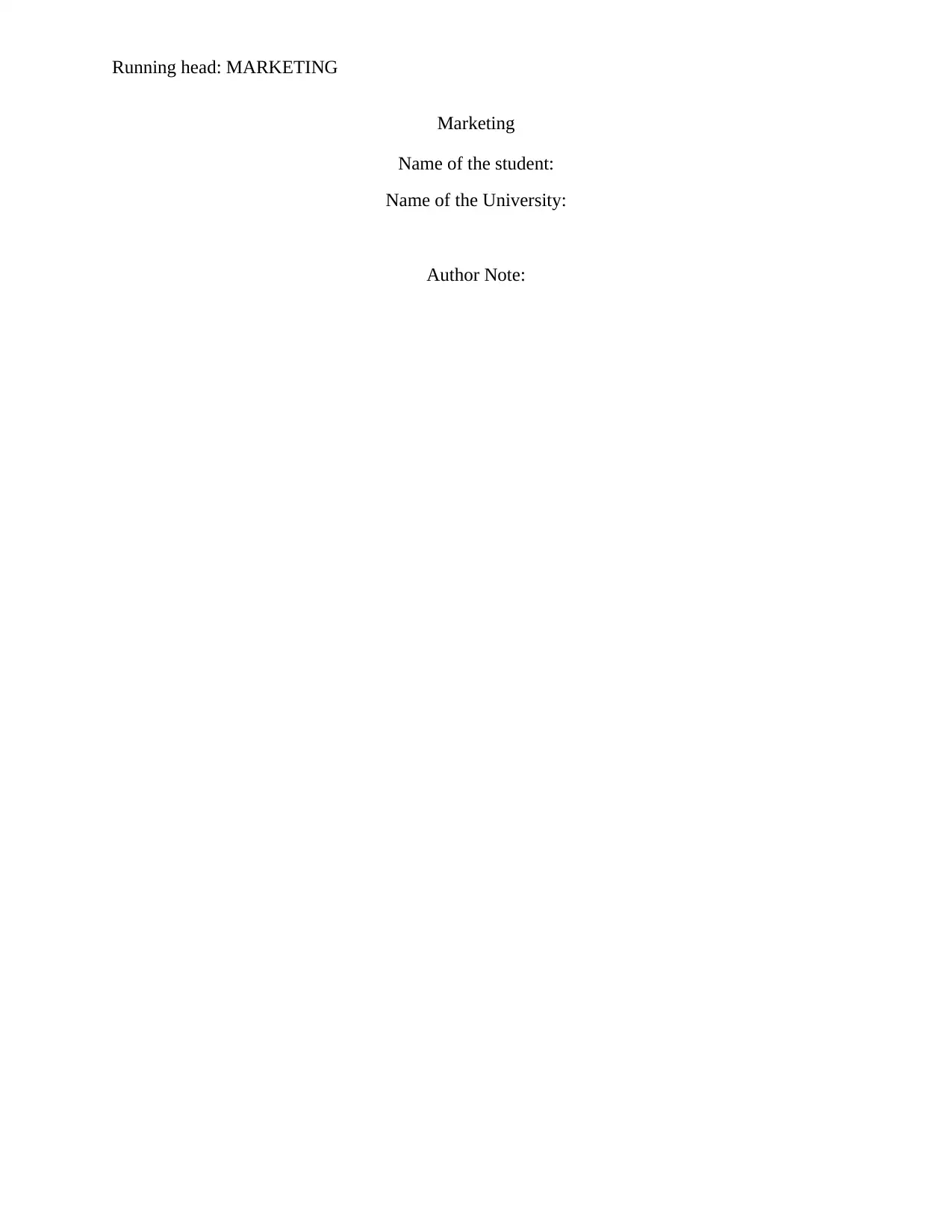
Running head: MARKETING
Marketing
Name of the student:
Name of the University:
Author Note:
Marketing
Name of the student:
Name of the University:
Author Note:
Paraphrase This Document
Need a fresh take? Get an instant paraphrase of this document with our AI Paraphraser
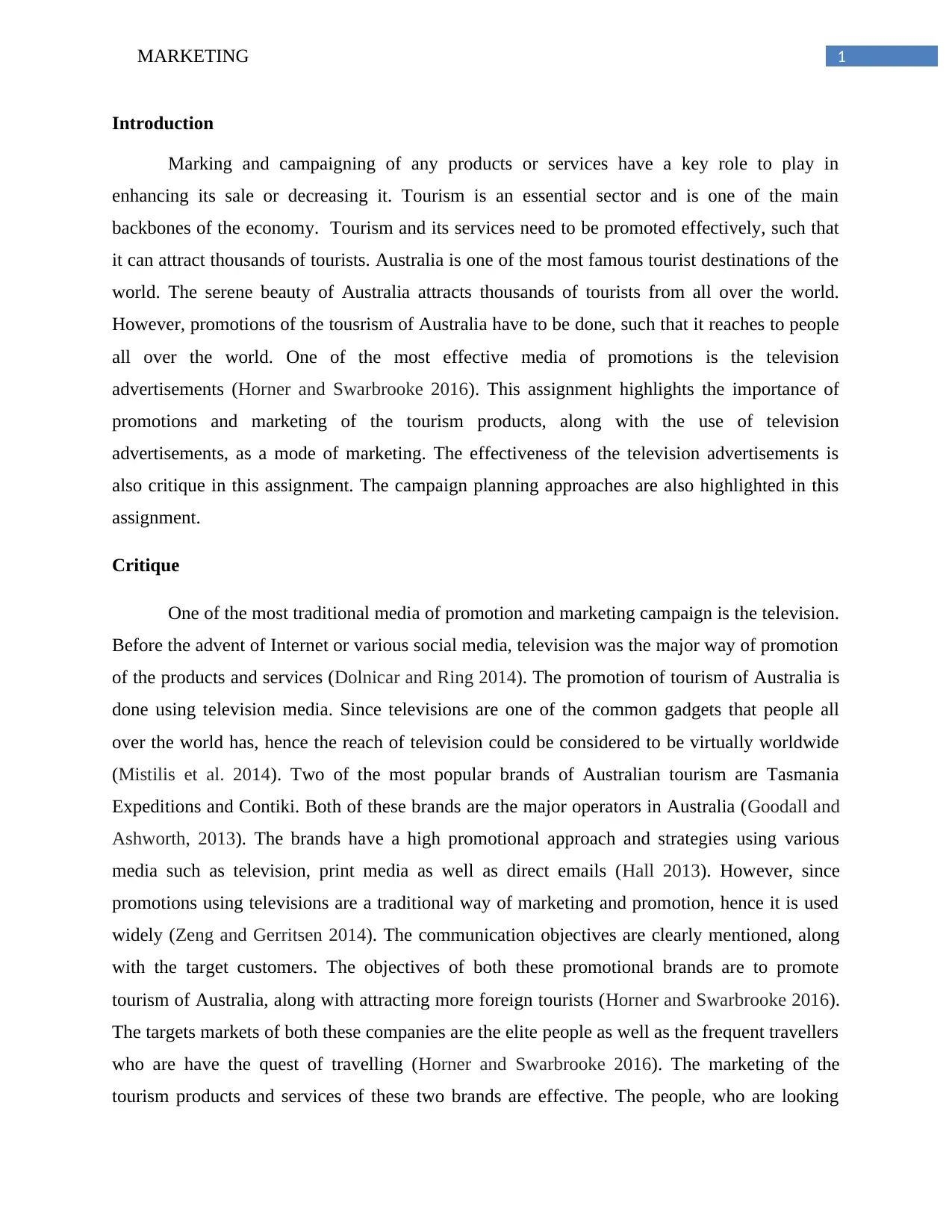
1MARKETING
Introduction
Marking and campaigning of any products or services have a key role to play in
enhancing its sale or decreasing it. Tourism is an essential sector and is one of the main
backbones of the economy. Tourism and its services need to be promoted effectively, such that
it can attract thousands of tourists. Australia is one of the most famous tourist destinations of the
world. The serene beauty of Australia attracts thousands of tourists from all over the world.
However, promotions of the tousrism of Australia have to be done, such that it reaches to people
all over the world. One of the most effective media of promotions is the television
advertisements (Horner and Swarbrooke 2016). This assignment highlights the importance of
promotions and marketing of the tourism products, along with the use of television
advertisements, as a mode of marketing. The effectiveness of the television advertisements is
also critique in this assignment. The campaign planning approaches are also highlighted in this
assignment.
Critique
One of the most traditional media of promotion and marketing campaign is the television.
Before the advent of Internet or various social media, television was the major way of promotion
of the products and services (Dolnicar and Ring 2014). The promotion of tourism of Australia is
done using television media. Since televisions are one of the common gadgets that people all
over the world has, hence the reach of television could be considered to be virtually worldwide
(Mistilis et al. 2014). Two of the most popular brands of Australian tourism are Tasmania
Expeditions and Contiki. Both of these brands are the major operators in Australia (Goodall and
Ashworth, 2013). The brands have a high promotional approach and strategies using various
media such as television, print media as well as direct emails (Hall 2013). However, since
promotions using televisions are a traditional way of marketing and promotion, hence it is used
widely (Zeng and Gerritsen 2014). The communication objectives are clearly mentioned, along
with the target customers. The objectives of both these promotional brands are to promote
tourism of Australia, along with attracting more foreign tourists (Horner and Swarbrooke 2016).
The targets markets of both these companies are the elite people as well as the frequent travellers
who are have the quest of travelling (Horner and Swarbrooke 2016). The marketing of the
tourism products and services of these two brands are effective. The people, who are looking
Introduction
Marking and campaigning of any products or services have a key role to play in
enhancing its sale or decreasing it. Tourism is an essential sector and is one of the main
backbones of the economy. Tourism and its services need to be promoted effectively, such that
it can attract thousands of tourists. Australia is one of the most famous tourist destinations of the
world. The serene beauty of Australia attracts thousands of tourists from all over the world.
However, promotions of the tousrism of Australia have to be done, such that it reaches to people
all over the world. One of the most effective media of promotions is the television
advertisements (Horner and Swarbrooke 2016). This assignment highlights the importance of
promotions and marketing of the tourism products, along with the use of television
advertisements, as a mode of marketing. The effectiveness of the television advertisements is
also critique in this assignment. The campaign planning approaches are also highlighted in this
assignment.
Critique
One of the most traditional media of promotion and marketing campaign is the television.
Before the advent of Internet or various social media, television was the major way of promotion
of the products and services (Dolnicar and Ring 2014). The promotion of tourism of Australia is
done using television media. Since televisions are one of the common gadgets that people all
over the world has, hence the reach of television could be considered to be virtually worldwide
(Mistilis et al. 2014). Two of the most popular brands of Australian tourism are Tasmania
Expeditions and Contiki. Both of these brands are the major operators in Australia (Goodall and
Ashworth, 2013). The brands have a high promotional approach and strategies using various
media such as television, print media as well as direct emails (Hall 2013). However, since
promotions using televisions are a traditional way of marketing and promotion, hence it is used
widely (Zeng and Gerritsen 2014). The communication objectives are clearly mentioned, along
with the target customers. The objectives of both these promotional brands are to promote
tourism of Australia, along with attracting more foreign tourists (Horner and Swarbrooke 2016).
The targets markets of both these companies are the elite people as well as the frequent travellers
who are have the quest of travelling (Horner and Swarbrooke 2016). The marketing of the
tourism products and services of these two brands are effective. The people, who are looking
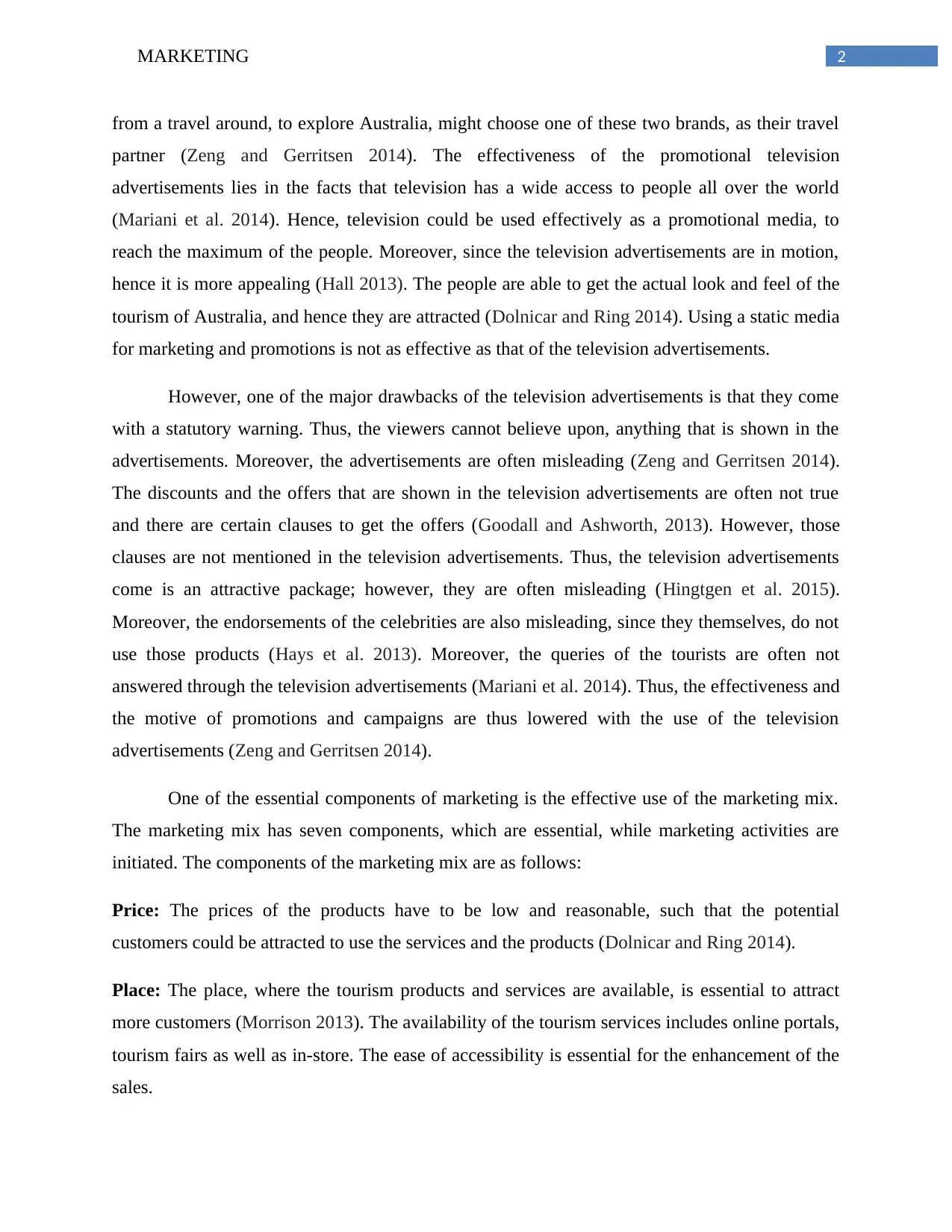
2MARKETING
from a travel around, to explore Australia, might choose one of these two brands, as their travel
partner (Zeng and Gerritsen 2014). The effectiveness of the promotional television
advertisements lies in the facts that television has a wide access to people all over the world
(Mariani et al. 2014). Hence, television could be used effectively as a promotional media, to
reach the maximum of the people. Moreover, since the television advertisements are in motion,
hence it is more appealing (Hall 2013). The people are able to get the actual look and feel of the
tourism of Australia, and hence they are attracted (Dolnicar and Ring 2014). Using a static media
for marketing and promotions is not as effective as that of the television advertisements.
However, one of the major drawbacks of the television advertisements is that they come
with a statutory warning. Thus, the viewers cannot believe upon, anything that is shown in the
advertisements. Moreover, the advertisements are often misleading (Zeng and Gerritsen 2014).
The discounts and the offers that are shown in the television advertisements are often not true
and there are certain clauses to get the offers (Goodall and Ashworth, 2013). However, those
clauses are not mentioned in the television advertisements. Thus, the television advertisements
come is an attractive package; however, they are often misleading (Hingtgen et al. 2015).
Moreover, the endorsements of the celebrities are also misleading, since they themselves, do not
use those products (Hays et al. 2013). Moreover, the queries of the tourists are often not
answered through the television advertisements (Mariani et al. 2014). Thus, the effectiveness and
the motive of promotions and campaigns are thus lowered with the use of the television
advertisements (Zeng and Gerritsen 2014).
One of the essential components of marketing is the effective use of the marketing mix.
The marketing mix has seven components, which are essential, while marketing activities are
initiated. The components of the marketing mix are as follows:
Price: The prices of the products have to be low and reasonable, such that the potential
customers could be attracted to use the services and the products (Dolnicar and Ring 2014).
Place: The place, where the tourism products and services are available, is essential to attract
more customers (Morrison 2013). The availability of the tourism services includes online portals,
tourism fairs as well as in-store. The ease of accessibility is essential for the enhancement of the
sales.
from a travel around, to explore Australia, might choose one of these two brands, as their travel
partner (Zeng and Gerritsen 2014). The effectiveness of the promotional television
advertisements lies in the facts that television has a wide access to people all over the world
(Mariani et al. 2014). Hence, television could be used effectively as a promotional media, to
reach the maximum of the people. Moreover, since the television advertisements are in motion,
hence it is more appealing (Hall 2013). The people are able to get the actual look and feel of the
tourism of Australia, and hence they are attracted (Dolnicar and Ring 2014). Using a static media
for marketing and promotions is not as effective as that of the television advertisements.
However, one of the major drawbacks of the television advertisements is that they come
with a statutory warning. Thus, the viewers cannot believe upon, anything that is shown in the
advertisements. Moreover, the advertisements are often misleading (Zeng and Gerritsen 2014).
The discounts and the offers that are shown in the television advertisements are often not true
and there are certain clauses to get the offers (Goodall and Ashworth, 2013). However, those
clauses are not mentioned in the television advertisements. Thus, the television advertisements
come is an attractive package; however, they are often misleading (Hingtgen et al. 2015).
Moreover, the endorsements of the celebrities are also misleading, since they themselves, do not
use those products (Hays et al. 2013). Moreover, the queries of the tourists are often not
answered through the television advertisements (Mariani et al. 2014). Thus, the effectiveness and
the motive of promotions and campaigns are thus lowered with the use of the television
advertisements (Zeng and Gerritsen 2014).
One of the essential components of marketing is the effective use of the marketing mix.
The marketing mix has seven components, which are essential, while marketing activities are
initiated. The components of the marketing mix are as follows:
Price: The prices of the products have to be low and reasonable, such that the potential
customers could be attracted to use the services and the products (Dolnicar and Ring 2014).
Place: The place, where the tourism products and services are available, is essential to attract
more customers (Morrison 2013). The availability of the tourism services includes online portals,
tourism fairs as well as in-store. The ease of accessibility is essential for the enhancement of the
sales.
⊘ This is a preview!⊘
Do you want full access?
Subscribe today to unlock all pages.

Trusted by 1+ million students worldwide
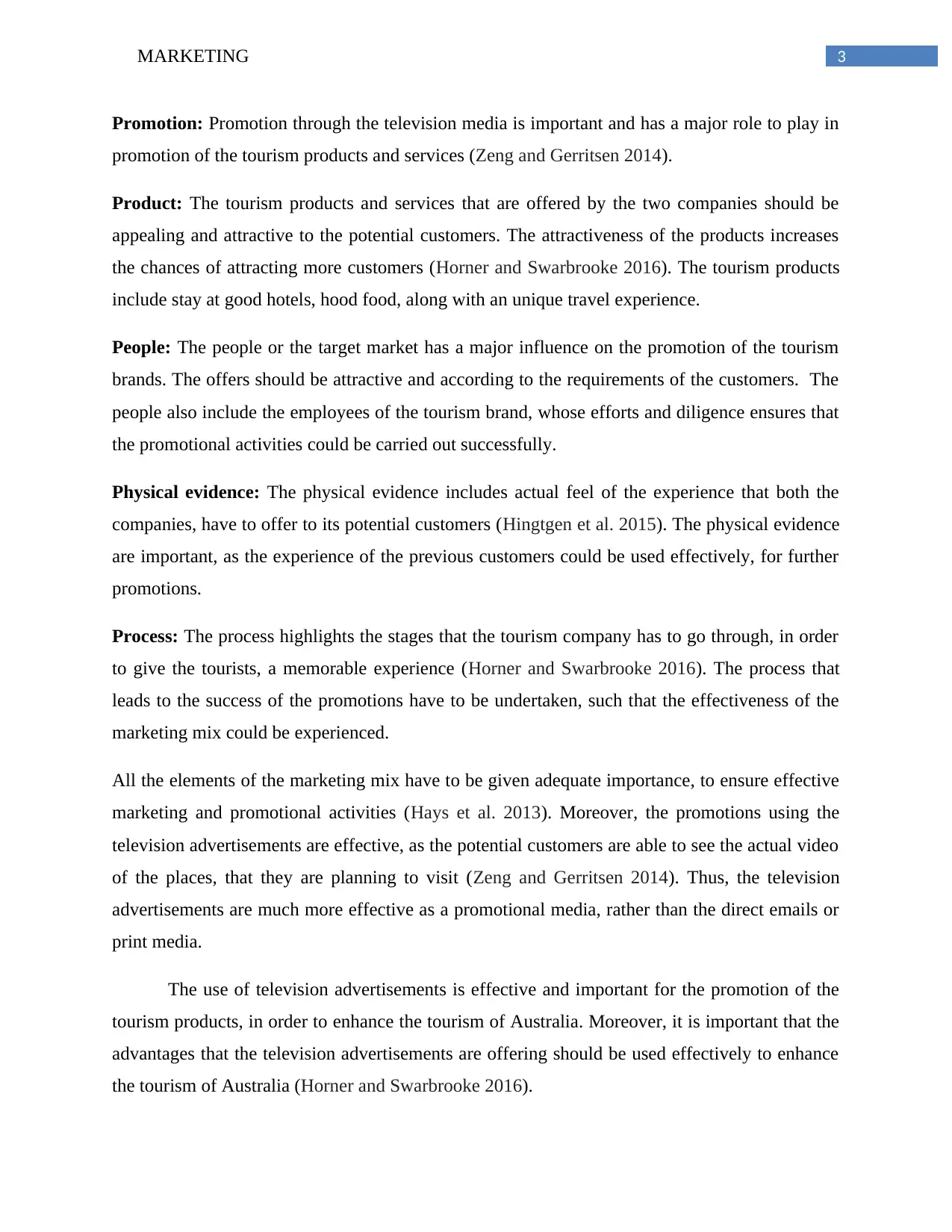
3MARKETING
Promotion: Promotion through the television media is important and has a major role to play in
promotion of the tourism products and services (Zeng and Gerritsen 2014).
Product: The tourism products and services that are offered by the two companies should be
appealing and attractive to the potential customers. The attractiveness of the products increases
the chances of attracting more customers (Horner and Swarbrooke 2016). The tourism products
include stay at good hotels, hood food, along with an unique travel experience.
People: The people or the target market has a major influence on the promotion of the tourism
brands. The offers should be attractive and according to the requirements of the customers. The
people also include the employees of the tourism brand, whose efforts and diligence ensures that
the promotional activities could be carried out successfully.
Physical evidence: The physical evidence includes actual feel of the experience that both the
companies, have to offer to its potential customers (Hingtgen et al. 2015). The physical evidence
are important, as the experience of the previous customers could be used effectively, for further
promotions.
Process: The process highlights the stages that the tourism company has to go through, in order
to give the tourists, a memorable experience (Horner and Swarbrooke 2016). The process that
leads to the success of the promotions have to be undertaken, such that the effectiveness of the
marketing mix could be experienced.
All the elements of the marketing mix have to be given adequate importance, to ensure effective
marketing and promotional activities (Hays et al. 2013). Moreover, the promotions using the
television advertisements are effective, as the potential customers are able to see the actual video
of the places, that they are planning to visit (Zeng and Gerritsen 2014). Thus, the television
advertisements are much more effective as a promotional media, rather than the direct emails or
print media.
The use of television advertisements is effective and important for the promotion of the
tourism products, in order to enhance the tourism of Australia. Moreover, it is important that the
advantages that the television advertisements are offering should be used effectively to enhance
the tourism of Australia (Horner and Swarbrooke 2016).
Promotion: Promotion through the television media is important and has a major role to play in
promotion of the tourism products and services (Zeng and Gerritsen 2014).
Product: The tourism products and services that are offered by the two companies should be
appealing and attractive to the potential customers. The attractiveness of the products increases
the chances of attracting more customers (Horner and Swarbrooke 2016). The tourism products
include stay at good hotels, hood food, along with an unique travel experience.
People: The people or the target market has a major influence on the promotion of the tourism
brands. The offers should be attractive and according to the requirements of the customers. The
people also include the employees of the tourism brand, whose efforts and diligence ensures that
the promotional activities could be carried out successfully.
Physical evidence: The physical evidence includes actual feel of the experience that both the
companies, have to offer to its potential customers (Hingtgen et al. 2015). The physical evidence
are important, as the experience of the previous customers could be used effectively, for further
promotions.
Process: The process highlights the stages that the tourism company has to go through, in order
to give the tourists, a memorable experience (Horner and Swarbrooke 2016). The process that
leads to the success of the promotions have to be undertaken, such that the effectiveness of the
marketing mix could be experienced.
All the elements of the marketing mix have to be given adequate importance, to ensure effective
marketing and promotional activities (Hays et al. 2013). Moreover, the promotions using the
television advertisements are effective, as the potential customers are able to see the actual video
of the places, that they are planning to visit (Zeng and Gerritsen 2014). Thus, the television
advertisements are much more effective as a promotional media, rather than the direct emails or
print media.
The use of television advertisements is effective and important for the promotion of the
tourism products, in order to enhance the tourism of Australia. Moreover, it is important that the
advantages that the television advertisements are offering should be used effectively to enhance
the tourism of Australia (Horner and Swarbrooke 2016).
Paraphrase This Document
Need a fresh take? Get an instant paraphrase of this document with our AI Paraphraser
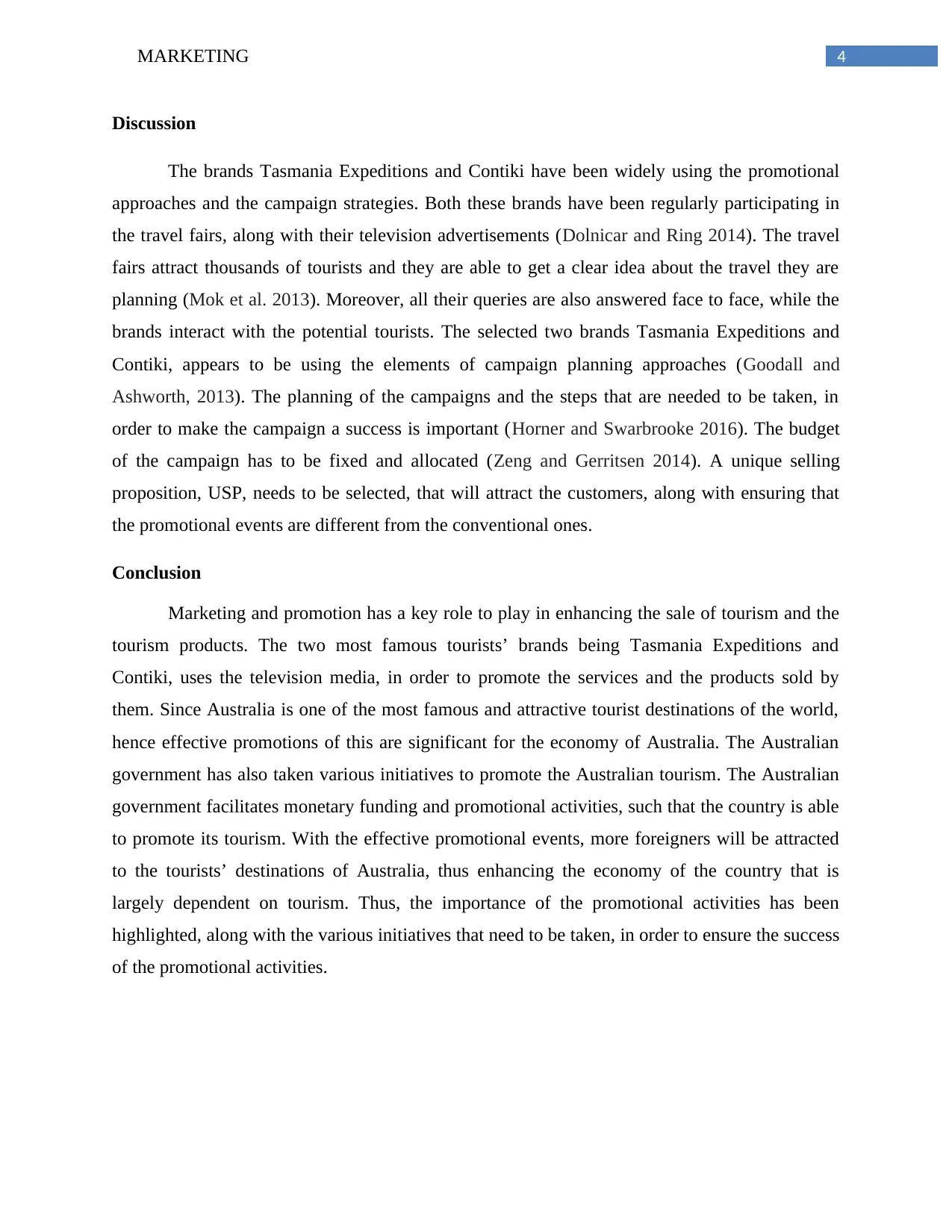
4MARKETING
Discussion
The brands Tasmania Expeditions and Contiki have been widely using the promotional
approaches and the campaign strategies. Both these brands have been regularly participating in
the travel fairs, along with their television advertisements (Dolnicar and Ring 2014). The travel
fairs attract thousands of tourists and they are able to get a clear idea about the travel they are
planning (Mok et al. 2013). Moreover, all their queries are also answered face to face, while the
brands interact with the potential tourists. The selected two brands Tasmania Expeditions and
Contiki, appears to be using the elements of campaign planning approaches (Goodall and
Ashworth, 2013). The planning of the campaigns and the steps that are needed to be taken, in
order to make the campaign a success is important (Horner and Swarbrooke 2016). The budget
of the campaign has to be fixed and allocated (Zeng and Gerritsen 2014). A unique selling
proposition, USP, needs to be selected, that will attract the customers, along with ensuring that
the promotional events are different from the conventional ones.
Conclusion
Marketing and promotion has a key role to play in enhancing the sale of tourism and the
tourism products. The two most famous tourists’ brands being Tasmania Expeditions and
Contiki, uses the television media, in order to promote the services and the products sold by
them. Since Australia is one of the most famous and attractive tourist destinations of the world,
hence effective promotions of this are significant for the economy of Australia. The Australian
government has also taken various initiatives to promote the Australian tourism. The Australian
government facilitates monetary funding and promotional activities, such that the country is able
to promote its tourism. With the effective promotional events, more foreigners will be attracted
to the tourists’ destinations of Australia, thus enhancing the economy of the country that is
largely dependent on tourism. Thus, the importance of the promotional activities has been
highlighted, along with the various initiatives that need to be taken, in order to ensure the success
of the promotional activities.
Discussion
The brands Tasmania Expeditions and Contiki have been widely using the promotional
approaches and the campaign strategies. Both these brands have been regularly participating in
the travel fairs, along with their television advertisements (Dolnicar and Ring 2014). The travel
fairs attract thousands of tourists and they are able to get a clear idea about the travel they are
planning (Mok et al. 2013). Moreover, all their queries are also answered face to face, while the
brands interact with the potential tourists. The selected two brands Tasmania Expeditions and
Contiki, appears to be using the elements of campaign planning approaches (Goodall and
Ashworth, 2013). The planning of the campaigns and the steps that are needed to be taken, in
order to make the campaign a success is important (Horner and Swarbrooke 2016). The budget
of the campaign has to be fixed and allocated (Zeng and Gerritsen 2014). A unique selling
proposition, USP, needs to be selected, that will attract the customers, along with ensuring that
the promotional events are different from the conventional ones.
Conclusion
Marketing and promotion has a key role to play in enhancing the sale of tourism and the
tourism products. The two most famous tourists’ brands being Tasmania Expeditions and
Contiki, uses the television media, in order to promote the services and the products sold by
them. Since Australia is one of the most famous and attractive tourist destinations of the world,
hence effective promotions of this are significant for the economy of Australia. The Australian
government has also taken various initiatives to promote the Australian tourism. The Australian
government facilitates monetary funding and promotional activities, such that the country is able
to promote its tourism. With the effective promotional events, more foreigners will be attracted
to the tourists’ destinations of Australia, thus enhancing the economy of the country that is
largely dependent on tourism. Thus, the importance of the promotional activities has been
highlighted, along with the various initiatives that need to be taken, in order to ensure the success
of the promotional activities.
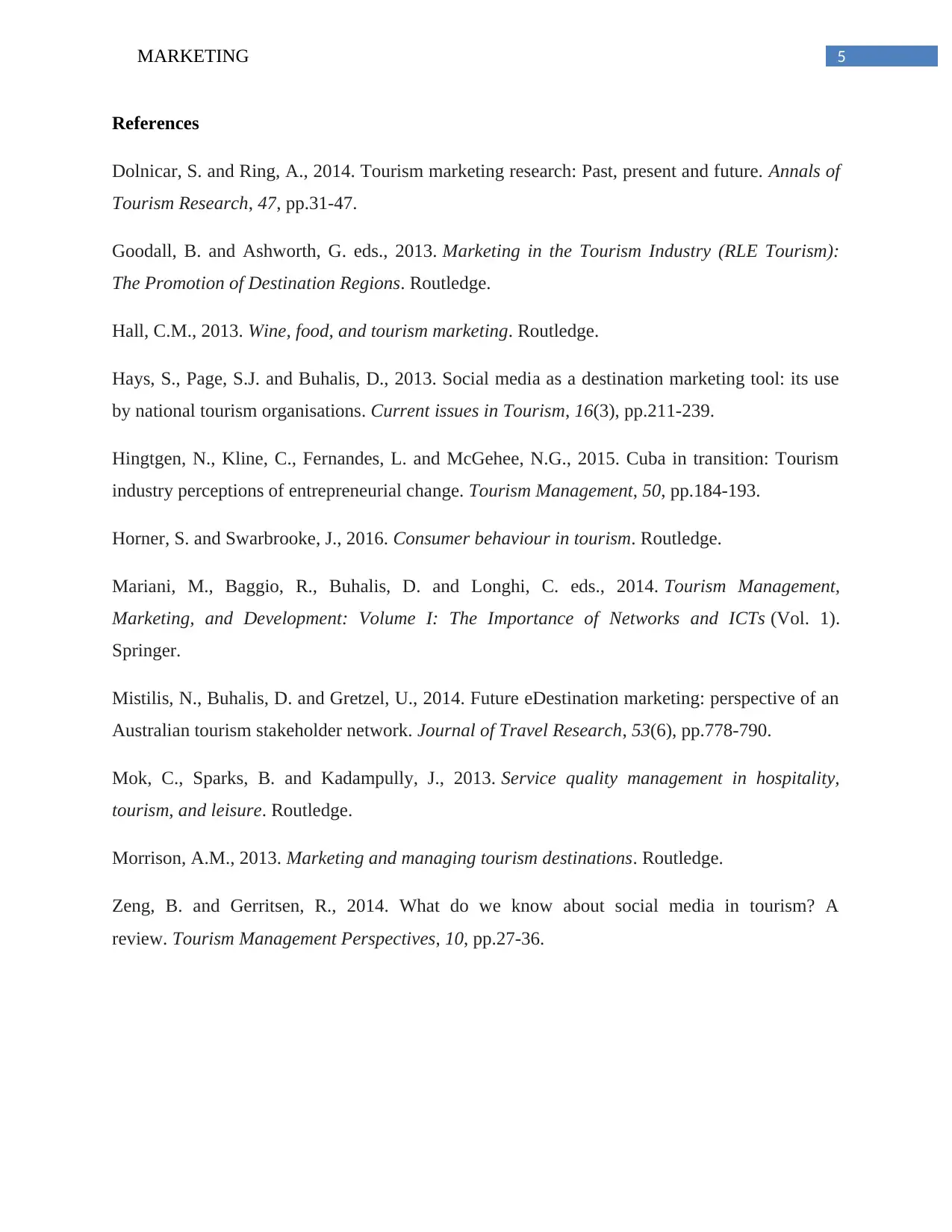
5MARKETING
References
Dolnicar, S. and Ring, A., 2014. Tourism marketing research: Past, present and future. Annals of
Tourism Research, 47, pp.31-47.
Goodall, B. and Ashworth, G. eds., 2013. Marketing in the Tourism Industry (RLE Tourism):
The Promotion of Destination Regions. Routledge.
Hall, C.M., 2013. Wine, food, and tourism marketing. Routledge.
Hays, S., Page, S.J. and Buhalis, D., 2013. Social media as a destination marketing tool: its use
by national tourism organisations. Current issues in Tourism, 16(3), pp.211-239.
Hingtgen, N., Kline, C., Fernandes, L. and McGehee, N.G., 2015. Cuba in transition: Tourism
industry perceptions of entrepreneurial change. Tourism Management, 50, pp.184-193.
Horner, S. and Swarbrooke, J., 2016. Consumer behaviour in tourism. Routledge.
Mariani, M., Baggio, R., Buhalis, D. and Longhi, C. eds., 2014. Tourism Management,
Marketing, and Development: Volume I: The Importance of Networks and ICTs (Vol. 1).
Springer.
Mistilis, N., Buhalis, D. and Gretzel, U., 2014. Future eDestination marketing: perspective of an
Australian tourism stakeholder network. Journal of Travel Research, 53(6), pp.778-790.
Mok, C., Sparks, B. and Kadampully, J., 2013. Service quality management in hospitality,
tourism, and leisure. Routledge.
Morrison, A.M., 2013. Marketing and managing tourism destinations. Routledge.
Zeng, B. and Gerritsen, R., 2014. What do we know about social media in tourism? A
review. Tourism Management Perspectives, 10, pp.27-36.
References
Dolnicar, S. and Ring, A., 2014. Tourism marketing research: Past, present and future. Annals of
Tourism Research, 47, pp.31-47.
Goodall, B. and Ashworth, G. eds., 2013. Marketing in the Tourism Industry (RLE Tourism):
The Promotion of Destination Regions. Routledge.
Hall, C.M., 2013. Wine, food, and tourism marketing. Routledge.
Hays, S., Page, S.J. and Buhalis, D., 2013. Social media as a destination marketing tool: its use
by national tourism organisations. Current issues in Tourism, 16(3), pp.211-239.
Hingtgen, N., Kline, C., Fernandes, L. and McGehee, N.G., 2015. Cuba in transition: Tourism
industry perceptions of entrepreneurial change. Tourism Management, 50, pp.184-193.
Horner, S. and Swarbrooke, J., 2016. Consumer behaviour in tourism. Routledge.
Mariani, M., Baggio, R., Buhalis, D. and Longhi, C. eds., 2014. Tourism Management,
Marketing, and Development: Volume I: The Importance of Networks and ICTs (Vol. 1).
Springer.
Mistilis, N., Buhalis, D. and Gretzel, U., 2014. Future eDestination marketing: perspective of an
Australian tourism stakeholder network. Journal of Travel Research, 53(6), pp.778-790.
Mok, C., Sparks, B. and Kadampully, J., 2013. Service quality management in hospitality,
tourism, and leisure. Routledge.
Morrison, A.M., 2013. Marketing and managing tourism destinations. Routledge.
Zeng, B. and Gerritsen, R., 2014. What do we know about social media in tourism? A
review. Tourism Management Perspectives, 10, pp.27-36.
⊘ This is a preview!⊘
Do you want full access?
Subscribe today to unlock all pages.

Trusted by 1+ million students worldwide
1 out of 6
Related Documents
Your All-in-One AI-Powered Toolkit for Academic Success.
+13062052269
info@desklib.com
Available 24*7 on WhatsApp / Email
![[object Object]](/_next/static/media/star-bottom.7253800d.svg)
Unlock your academic potential
Copyright © 2020–2025 A2Z Services. All Rights Reserved. Developed and managed by ZUCOL.




